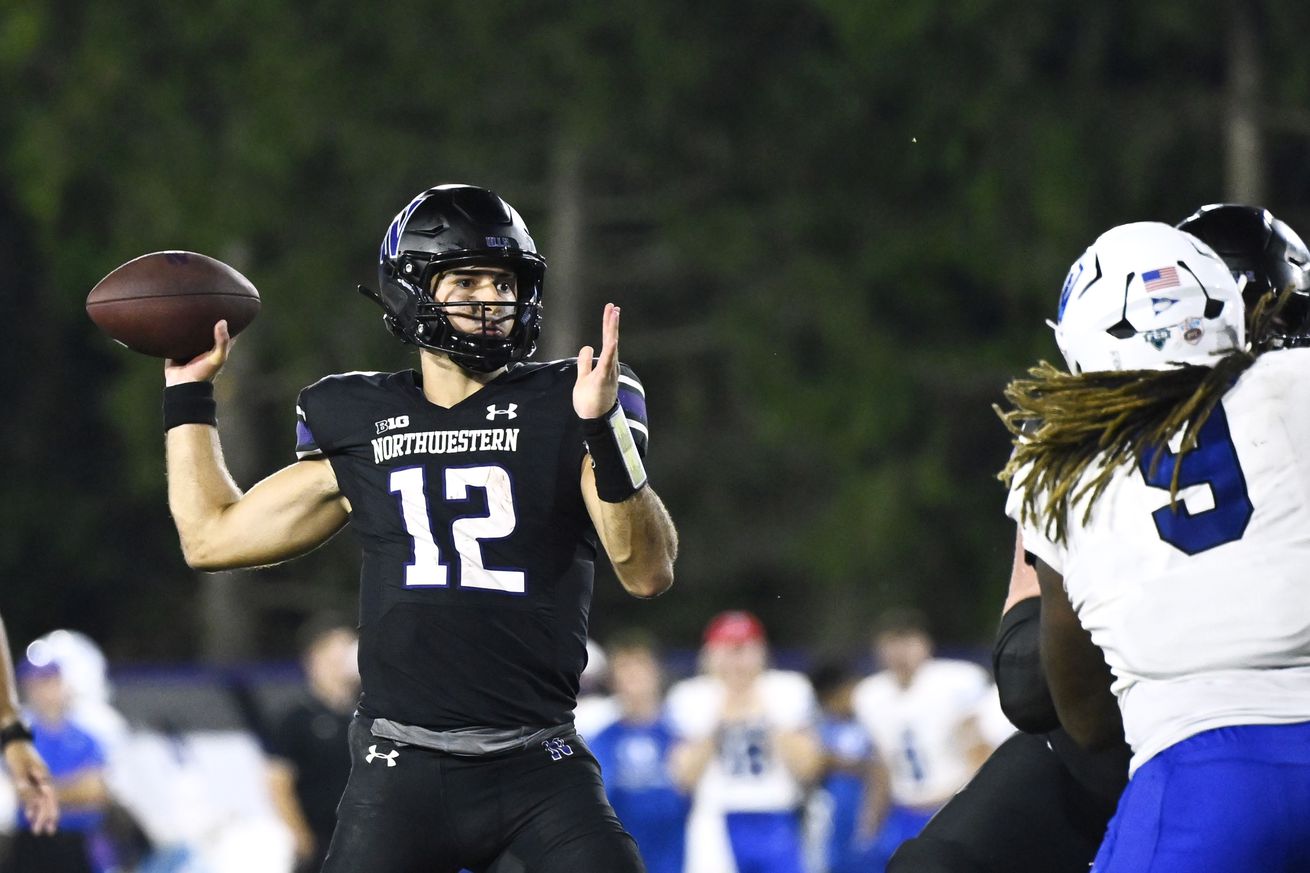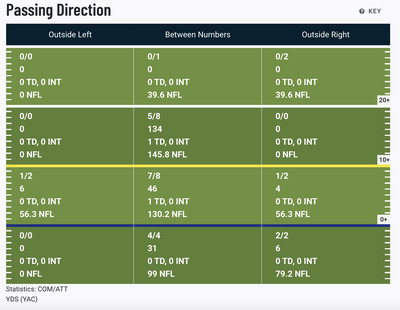
In his first career start, Lausch went from lost to balling in 20 minutes.
Welcome back to the film room everybody.
After a devastating double-overtime loss to Duke, David Braun and Co. decided to make a switch under center. The Wildcats turned the offense over to redshirt sophomore Jack Lausch when they welcomed Eastern Illinois to Evanston. It was the first start for Lausch in his young career, and like most first-time starters, Saturday night was full of highs and lows for No. 12. To be specific, the first half was rough, but the second half was spectacular.
Because of the dichotomy of the two halves, we are going to stray from the usual format of this piece. Normally we start with the good and then finish with the bad, but today we’re going to look at what caused the difference between the first and second half. However, let’s start with the numbers.
The Numbers
Lausch finished his first start 20-of-31 for 227 yards, two touchdowns and no interceptions. No. 12 also added 67 yards on the ground, including three carries of more than 10 yards. On Saturday, Lausch averaged 7.3 yards per attempt, the highest by a ‘Cats’ QB this season. For his effort, the redshirt sophomore earned a 75.0 PFF grade — comprising of a 74.8 PFF passing grade and a 63.0 PFF rushing grade.
Lausch’s 20-of-31 is a perfect example of the difference between both halves. Lausch started the game 4-of-13 for 16 yards before a good two-minute drive, but he completed all 11 passing attempts in the second half. While Lausch may have struggled to hook up with his receivers in the first half, he never put the ball in harm’s way. According to PFF, NU’s gunslinger had zero turnover-worthy plays. All week, David Braun stressed taking care of the football, and Lausch did exactly that.
No. 12 should thank his offensive line for keeping him upright all night, facing pressure on just 25% of his dropbacks. Even when he was under duress, the Chicago native was 3-of-7 for 28 yards and a touchdown. Lausch also did a good job pushing the ball down the field, taking 11 shots more than 10 yards down the field. Here is the complete breakdown of Lausch’s tosses from Saturday.

While the overall numbers look promising, numbers do not always tell the full story. So without wasting any more time, let’s dive into the tape.
First Half
For the first 28 minutes of the game, it did not look promising for Lausch. Sitting at 4-of-13 for 16 yards against an FCS squad, I was convinced that the Jack Lausch experiment would be over in the second half. I even bet a couple of the West Lot Pirates (hosts of a pretty sweet tailgate) five bucks that Mike Wright would be under center to start the second half. We’re going to hit a couple of plays that left me concerned that NU was not in a position to succeed against the Panthers.
This was the play that concerned me the most in the first half.
Back in April, the last time I saw Lausch throw a football, he did the same exact thing. On a deep ball, he threw a helicopter ball probably 10 yards short of the receiver. He does the same thing right here. The ball did not have a tight spiral on it, and Kirtz had no chance to make a play because the ball was severely underthrown. The footwork looks fine, Lausch just has to throw a better ball.
The same problem as the last play.
Kirtz has inside leverage on the corner, so his dig route is open for the first down; however, he never has a chance because Lausch spikes the ball right into the dirt. I would love for No. 12 to transfer more of his weight to his front foot so he can drive the ball. Instead, he speeds up his footwork and the ball ends up diving on him.
This got cleaned up as the game went on because he slowed down and got more comfortable, so this is not a big concern I have moving into the rest of the season.
If you have read this column, you know why this play bothers me so much.
The pocket is clean and every defender is blocked, so there is no reason to be bailing out of the pocket — especially through the back of the pocket, Now, Lausch is able to get around the defender for a positive gain, but he still comes up short of the first down. If he just stayed in the pocket for a second or two longer, he may have been able to find a receiver downfield for a fresh set of downs.
This is something that Zach Lujan needs to get out of his game quickly. This exact problem is what made Brendan Sullivan a liability under center. So if the ‘Cats want Lausch to be their long-term solution, he needs to improve on standing tall in the pocket. He may be able to get away with it against Eastern Illinois, but Big Ten teams will make him pay.
Two Minute drill
The turning point of the game. With no time to think, Lausch started to play freely and connect with his receivers. After struggling for the entire first half, the two-minute drill allowed Lausch to recenter himself and just play football. After this drive, he was composed and dialed in for the rest of the night.
The play where something clicked.
EIU brings a corner blitz, but Joe Himon II does a good job picking it up. Lausch senses the pressure off the edge and steps up in the pocket. Once he steps up, he feels the DT barreling down on him, so he moves to his right to the vacated space that the corner blitz would normally occupy. While doing all of this in the pocket, No. 12 keeps his eyes downfield the entire play and delivers a strike to Marshall Lang for a big gain.
Plays like this are what excites Braun and Co. about Lausch. His fundamentals stay consistent the entire time, but his athleticism takes over and creates a big play that eventually results in points. If this is the type of play he can make regularly, Lujan’s offense will find another gear.
Second half
Alright, let’s have some fun.
I still don’t understand how this complete 180 happened from the first half, but I’m not mad about it. Lausch seemed to settle into Lujan’s scheme in the second half and executed it to perfection. Once he found his groove, he was dominant.
My favorite play of the night, but not for the reason you may think.
Northwestern runs a flood concept, which is the outside receiver on a go route, the slot receiver running a shallow speed out and the tight end running a 10-yard out. The read here is if the QB likes the go route pre-snap, he’ll take it. Otherwise, it is the shallow out then the deep out. EIU is playing a version of cover four, so the corner and the safety take away the go ball. The nickel is responsible for the flat, so he takes away the shallow out.
What I love the most about this is watching Lausch go through his progression. He peeks the go ball, then moves his eyes and shoulders over to the shallow out and finally works back to the out and delivers a bullet for the first down. The redshirt sophomore never locks in on any one receiver; instead, he goes from one to two to three and finds the open man.
For his first start, processing all that in just three seconds is a great sign for the Wildcats. As he gets more game reps, he is only going to get better.
When you play within the system, the system gives back to you.
On the RPO, EIU’s linebacker is flat-footed, so A.J. Henning gets behind him. Lausch diagnoses the linebacker during his ride and picks it up correctly. He pulls the ball out of Cam Porter’s gut, resets his feet and fires an easy completion to No. 8 for a huge gain.
It’s simple, but it’s not always easy for a young player to play within the offense and just take what is in front of them. I was impressed that as the game went on, Lausch started to rely less on his legs and trusted that the scheme around him worked. As I said on X last week, the scheme is fine, but the 11 on the field needed to execute better. This past weekend, we saw how dynamic the offense can be when it’s run correctly.
Final thoughts
Was it perfect? No, but I was incredibly impressed by the way Lausch turned a poor start around and ended up having a strong showing. However, this is what a Big Ten team should do to an FCS team. The level of play is about to increase tremendously, so another 4-of-13 start could put NU out of a game in a hurry.
I’m not ready to anoint him the future of Northwestern football just yet, but if Jack Lausch can build on a tremendous second half and lead the Wildcats’ offense to a solid performance in Seattle, the future of the ‘Cats will be a whole lot brighter. It’s been one game, so I’m still skeptical, but the opportunity is there for No. 12 to seize.
